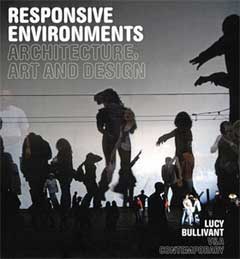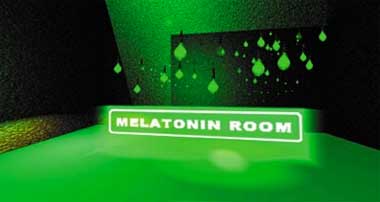 Responsive Environments: Architecture, Art and Design (USA – UK) by Lucy Bullivant, an architectural critic, author and curator based in London.
Responsive Environments: Architecture, Art and Design (USA – UK) by Lucy Bullivant, an architectural critic, author and curator based in London.
Extract from the editor’s blurb: Artistic manifestations of the use of digital technology in physical spaces are growing. Electronic billboards have been around for decades, but now the concept of connectivity has also literally seeped into the skins of buildings in new ways. Artists – and architects working in hybrid fields on interactive projects – are responding to the electro-physical flux of urban environments, coopting responsive dynamic media systems, wireless sensing, wearable computing and even topological media. They (…) are not interested in ‘tech’ or smart spaces for the sake of it, but to create environments that act as mediating devices for a new social statement.
I found about the book on Interactive Architecture. As Ruairi notes, several blogs were mentionned as a resource for the book: Interactive Architecture, Pixelsumo, Gizmodo and we-make-money-not-art. That reaaaally made my day. I ordered it immediately as Bullivant is also the author of a small book i read last year and liked a lot 4dspace: Interactive Architecture (UK – USA.)
Responsive Environments is not big on theories and risky forecasts, it’s rather a walk into the best and the latest of what interactive space can mean. It is split in small chapters (about interactive building skins, intelligent walls and floors, responsive artworks, etc.) and has plenty of beautiful pictures. Although the book deals with technology-heavy installations and concepts, i never felt i needed a degree in engineering to understand it, there’s even a glossary that explains what are Bluetooth, LEDs, RFID tags, etc. All of the above makes a very easy read, although i sometimes had the feeling i was reading a catalogue.
I was very happy to “hear the voice” of the artists, interaction designers and architects themselves as Bullivant has interviewed names most of you are familliar with: Jason Bruges, Lars Spuybroek, Ben Rubin, Rafael Lozano Hemmer, Christian Moeller, Usman Haque, HeHe, Shona Kitchen and Ben Hooker, Golan Levin, Toyo Ito, UN Studio, Mark Goulthorpe, Toshio Iwai and KDa, Maywa Denki, Kas Oosterhuis, Tobi Schneidler, Realities:united, Adam Somlai-Fischer, etc.

The project (well… one of the many projects) i discovered in this book is the Melatonin Room, by Swiss architects Jean-Gilles Decosterd and PhilippeRahm (the studio is now closed but you can learn more about their work here).
The melatonin regulates levels of alertness in the human body. A high level induces sleepiness, a low level greater alertness. Two climates alternate in the Melatonin Room. The first is defined by the emission of a bright green electromagnetic radiation at 509 nm, at an intensity of 2000 lux, which eliminates the production of melatonin, the space becomes thus a physically motivating place. The second climate is a dissemination of ultraviolet rays, bathing the visitor in soft blue light which stimulate the production of melatonin. This “physiological architecture” explores the ways environments can change consciousness.
